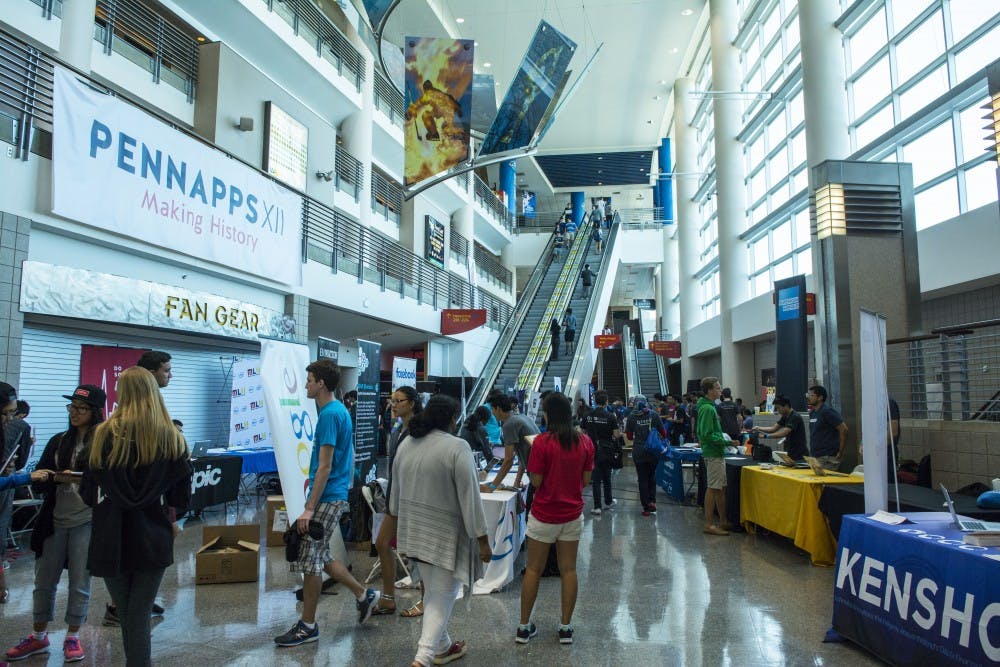In 36 hours, Swarthmore College sophomore Rachel Diamond slept for only a total of nine hours, collected more than a dozen items of sponsor-branded free swag and witnessed the greatest supply of free bananas in her life.
Diamond was a first-time participant at PennApps, which was hosted by Penn at the Wells Fargo Center in South Philadelphia this past weekend. Early Sunday morning, she wore denim shorts and a lavender T-shirt , looking far more put together than her fellow participants clad in pajamas and swaddled in fleece blankets. Her work area was piled with so many sponsor T-shirts that it seemed as if she had taken every single free item offered at the hackathon.
“My friend and I came together because we thought it would be fun to participate,” Diamond said. “But we soon realized that we were in over our heads, so we’re just here to have fun and see the cool projects.”
At 8:40 a.m. on Sunday morning, the tension was palpable in the Wells Fargo Center. The teams only had 20 minutes left to submit their “hacks” — hardware or software solutions to real world problems. Loops of white tables were filled with students, uneaten food and tangled cords. Other participants were still rolling out of air mattresses and sleeping bags as multiple cell phone alarms simultaneously rang.
The Wells Fargo Center, filled with 2,000 of the nation’s best young software and hardware designers, was a huge change in venue. In past years, the event was hosted on Penn’s campus, but the growth in PennApps both in terms of name and participation resulted in the move off campus.
“I thought the Wells Fargo Center had a great set-up because you could see all these people working on their projects,” Carnegie Mellon Engineering sophomore and Grand Prize winner Edward Ahn said. “There was a really collective and helpful atmosphere, while if you do it at a university, people will usually separate.”
By 9:30 a.m., participants were supposed to have submitted their work. Soon after, the first expo began, where half the teams presented their projects.
Sponsors continued to hand out free items, simultaneously pitching their companies to wandering hackers. From L-3 Communications — a defense contractor — to Comcast, from Goldman Sachs to Uber, representatives from companies grabbed any and every opportunity to talk about their company and gauge the hackers’ interest in future internships. “Companies do a lot of recruiting at PennApps,” Diamond said. “A lot of large companies like Google, Uber and Microsoft are here, but this is also a good event for small companies to get their names out.”
During the hackathon, many of the women’s bathroom signs had also been covered by the men’s bathroom logo. The sign changes were a subtle indication of the gender gap pervading within the tech industry — PennApps had far more male participants than female participants.
Nevertheless, Engineering and Wharton sophomore Devesh Dayal, head of marketing and press for the event, said that 20 percent of the participants were female, which was a large improvement from previous years.
At 11:30 a.m. hundreds of students filed into the arena for the second expo round. Many fiddled with their devices and conversed with their teammates as other participants walked around to view their rivals’ projects.
Carnegie Mellon sophomore Dylan Steele created an app called Phonograph, which was marketed as a “Spotify that can work without Wi-Fi.” Another app called “uShould,” designed by four students including College junior Q Kalantary and Wharton and College junior Daniel Kwak, was a “health habit forming app” that used elements of hardware to set alarms based on touch sensors.
For the next few hours, the arena buzzed as re-energized students presented their innovative hardware and software designs.
Finally, the awards ceremony began at 2:00 p.m., recognizing teams that had found success hacking through different “routes” such as education and health, and those who had won company-sponsored prizes.
For the Grand Prize winners — Carnegie Mellon Engineering sophomores Edward Ahn, Rajat Mehndiratta, Vasu Agrawal and Cyrus Tabrizi — it was not all smooth sailing to the finish line of their app, FifthSense.
Mehndiratta described the project as an assistance device for visually impaired people that would allow them to interact with technology such as smartphones. There were six buttons on the back of the device that people could use to communicate braille patterns.
With only 36 hours to finish their design, they struggled with timing their tasks.
“We did quite a bit of brainstorming. The first night, we only finalized our idea at 4 or 5 a.m. in the morning when everyone was asleep, so we actually only spent about 24 hours working on the project,” Agrawal said.
Their sleepless nights paid off as their hack, FifthSense, won not only the Grand Prize, but also Best Hardware Hack and Best AlphaLab Gear Hardware Hack.
“We tried to not only make it ergonomic by testing the natural arrangement of our fingers," Mehndiratta said, "but we also tried to make it as fast and usable as possible because we thought no one had really done that."









